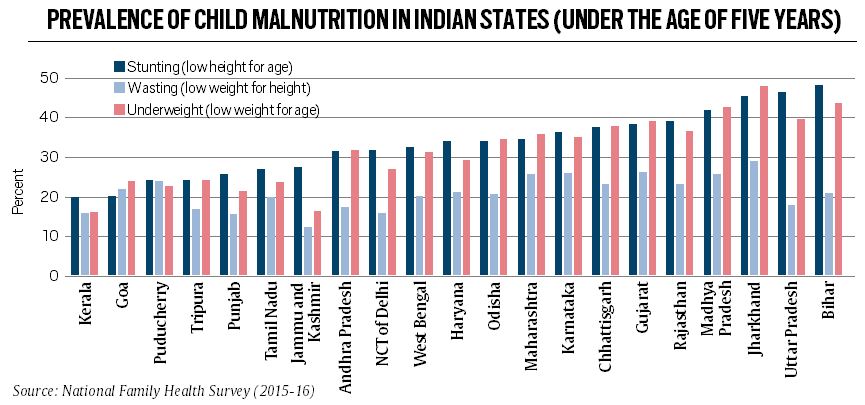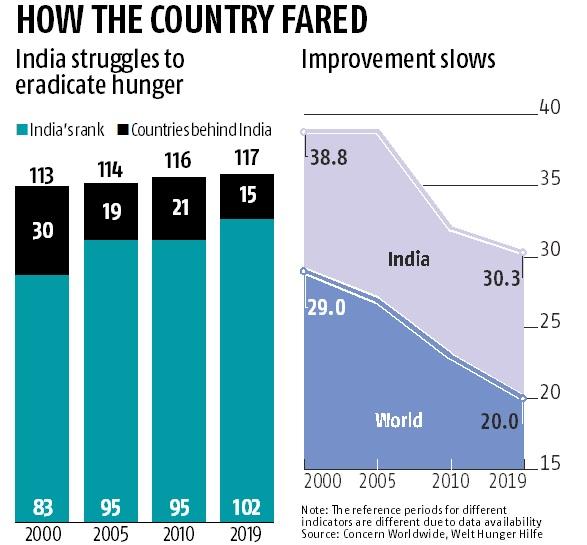Focus: GS-II Social Justice
To ensure good health by 2023, focus on agriculture, sanitation, women education:
Why in news?
President Donald Trump applauded India’s achievements in his February 24. These achievements ranged from religious freedom to reducing poverty to becoming an emerging giant economy.
Facts about Poverty reduction:
The World Bank’s estimates of extreme poverty — measured as $1.9/per capita/per day at purchasing power parity of 2011 — show a secular decline in India from 45.9 per cent to 13.4 per cent between 1993 and 2015 (See figure: Poverty headcount ratio in India).

Source: National Family Health Survey (2015-16)
Future path of poverty reduction:
- If the overall growth process continues as has been the case since, say, 2000 onwards, India may succeed in eliminating extreme poverty by 2030, if not earlier.
- Also, given the overflowing stock of food grains with the government, and a National Food Security Act (NFSA) that subsidises grains to the tune of more than 90 per cent of its cost to 67 per cent of the population, there is no reason to believe that India can also not attain the goal of zero hunger before 2030.
Challenge of health:
- The real challenge for India, however, is to achieve the third goal of good health and well-being by 2030. India’s performance in this regard, so far, has not been satisfactory.
- In 2015-16, almost 38.4 per cent of India’s children under the age of five years were stunted, 35.8 per cent were underweight and 21 per cent suffered from wasting (low weight for height), as per the National Family Health Survey (NFHS 2015-16).
- The situation in some states like Bihar, Jharkhand and Uttar Pradesh is even worse
- No wonder, the Global Hunger Index (GHI) ranks India at 102 out of 117 countries in terms of the severity of hunger in 2019.
How can India overcome this colossal challenge of malnutrition?
- The National Nutrition Strategy, 2017, aims to reduce the prevalence of underweight children (0-3 years) by three percentage points every year by 2022 from NFHS 2015-16 estimates.
- This is an ambitious target given the decadal decline in underweight children from 42.5 per cent in 2005-06 to 35.8 per cent in 2015-16 amounts to less than 1 per cent decline per year.
- Similar targets have been set by the National Nutrition Mission (renamed as POSHAN Abhiyaan), 2017, to reduce stunting, undernutrition, anemia (among young children, women and adolescent girls) and low birth weight by 2 per cent, 2 per cent, 3 per cent and 2 per cent per annum respectively.
Four key areas,
if India has to make a significant dent on malnutrition by 2030
First and foremost, is the mother’s education. It is one of the most important factors that has a positive multiplier effect on child care and access to healthcare facilities. It also increases awareness about nutrient-rich diet, personal hygiene, etc. This can also help contain the family size in poor, malnourished families. Thus, a high priority to female literacy, in a mission mode through liberal scholarships for the girl child, would go a long way towards tackling this problem.
Second is the access to improved sanitation and safe drinking water. From that angle, the Swachh Bharat Abhiyan and Jal Jeevan Mission would have positive outcomes in the coming years.
Third, there is a need to shift dietary patterns from cereal dominance to the consumption of nutritious foods such as livestock products, fruits and vegetables, pulses, etc. But they are generally costly and their consumption increases only by higher incomes and better education. Diverting a part of the food subsidy on wheat and rice to more nutritious foods can help.
Finally, India must adopt
new agricultural technologies of bio-fortifying cereals, such as zinc-rich
rice, wheat, iron-rich pearl millet, and so on.
Conclusion:
- Global experience shows that with the right public policies focusing on agriculture, improved sanitation, and women’s education, one can have much better health and well-being for its citizens, especially children.
- In China, it was agriculture and economic growth that significantly reduced the rates of stunting and wasting among the population and lifted millions of people out of hunger, poverty and malnutrition.
- According to FAO, Brazil and Ethiopia have transformed their food systems: They have targeted their investments in agricultural R&D and social protection programmes to reduce hunger in the country.
- Despite India’s improvement in child nutrition rates since 2005-06, it is way behind the progress experienced by China and many other countries.
- According to the Global Nutrition Report, 2016, at the present rates of decline, India will achieve the current stunting rates of China by 2055. India can certainly do better, but only if it focuses on this issue.
Background:
About Global Hunger Index:
- The Global Hunger Index (GHI) is a tool designed to comprehensively measure and track hunger at global, regional, and national levels.
- The GHI is designed to raise awareness and understanding of the struggle against hunger, provide a way to compare levels of hunger between countries and regions, and call attention to those areas of the world where hunger levels are highest and where the need for additional efforts to eliminate hunger is greatest.
- GHI is calculated each year to assess progress and setbacks in combating hunger. It scores on a 100-point GHI Severity Scale, where 0 is the best score (no hunger) and 100 is the chronic undernutrition.
- Indicators for Calculating GHI Score:
- UNDERNOURISHMENT: the share of the population that is undernourished (caloric intake is insufficient);
- CHILD WASTING: the share of children under the age of five who are wasted (low weight for their height, reflecting acute undernutrition);
- CHILD STUNTING: the share of children under the age of five who are stunted (low height for their age, reflecting chronic undernutrition); and
- CHILD MORTALITY: the mortality rate of children under the age of five (reflection of the fatal mix of inadequate nutrition and unhealthy environments).

In the recently released Global Hunger Index (GHI) Report-2019, India was ranked at 102nd position out of 117 countries.
The report is an annual publication that is jointly prepared by the Concern Worldwide (an Irish agency) and the Welt Hunger Hilfe (a German organization).
About POSHAN Abhiyaan:
- POSHAN Abhiyaan (National Nutrition Mission) was launched in 2018 by the Prime Minister in Jhunjhunu, Rajasthan.
- It targets to reduce level of under-nutrition and other related problems by ensuring convergence of various nutrition related schemes
- It also targets stunting, under-nutrition, anaemia (among young children, women and adolescent girls) and low birth rate.
- It will monitor and review implementation of all such schemes and utilize existing structural arrangements of line ministries wherever available.
- Its large component involves gradual scaling-up of interventions supported by on-going World Bank assisted Integrated Child Development Services (ICDS) Systems Strengthening and Nutrition Improvement Project (ISSNIP) to all districts in the country by 2022.
- Its vision is to ensure attainment of malnutrition free India by 2022.




